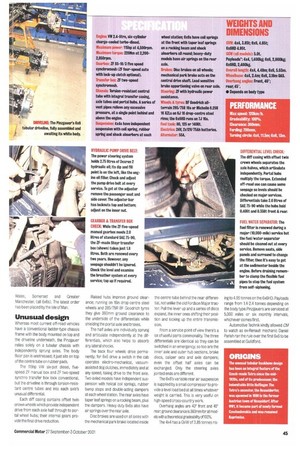RI NIGAIIERS
Page 44

Page 45

If you've noticed an error in this article please click here to report it so we can fix it.
GET ON 11111111
Few pundits predicted that Magna Steyr would switch Pinzgauer production from Graz in Austria to sunny Surrey, but last year the firm did just that, handing Automotive Technik Ltd (ATL) a 10-year licence to build the range for all markets.
The Austrian manufacturing giant, which builds vehicles for Daimler Chrysler, desperately needed extra space to add Saab Cabriolet models to its Mercedes Mand E-class production flows.
"Graz was building just 600 Pinzgauers annually but had 15 years' worth of orders from foreign military forces so the move was logical," says ATL director David Findlay. "For us, the timing couldn't have been better."
The Guildford firm already provided technical assistance to the British Army and RAF medical services and handled other UK Pinzgauer exports, supplies and technical back-up: the clincher was the UK's enviable position as a worldwide military defence supplier with extremely good vehicle manufacturing skills and marketing support systems.
Production is at Guildford with bodies-in-white with final coating by Mayflower in Coventry and other fabrications, arriving from Automotive Technik's Fareham factory.
Fully manned the plant could produce around 2,000 vehicles a year, but in these early stages it is building three a week, rising to five next year.
The bulk of its orders have been placed by the UK MoD, which already has about 700 Pinzgauers in service including gun tractors and limbers, communications shelters, missile carriers and ambulances serving with Army, RAF, Navy and Royal Marines.
Overseas interest comes mainly from the UAE, Saudi Arabia, Oman and Croatia while fire brigade users include North Wales, Somerset and Greater Manchester, (all 6x6s). The latest order has been placed by the Isle of Man.
Unusual design
Whereas most current off-road vehicles have a conventional ladder-type chassis frame with the body mounted on top and the driveline underneath, the Pinzgauer relies solely on a tubular chassis with independently sprung axles. The body floor pan is unstressed; it just sits on top of the centre tube on rubber pads.
The 115hp VW six-pot diesel, fivespeed ZF manual box and ZF two-speed synchro transfer box look conventional, but the driveline is through torsion-resistant centre tubes and into each axle's unusual differential.
Each diff casing contains offset twin crown wheels which provide independent drive from each axle half through to portal wheel hubs; their internal gears provide the final drive reduction. Raised hubs improve ground clearance; running on 16in drop-centre steel wheels and 285/75R BF Goodrich tyres they give 360mm ground clearance to the underside of the differentials while shielding the portal axle and brakes.
The half axles are individually sprung and articulate independently at the differentials, which also helps to absorb any lateral shocks.
The back four wheels drive permanently; for 6x6 drive a switch in the cab operates electro-mechanical, vacuumassisted dog clutches, immediately and at any speed, taking drive to the front axle. Two-wiled models have independent suspension with helical coil springs, rubber bump stops and double-acting dampers at each wheel station. The rear axles have taper leaf springs on a rocking beam, plus the dampers. Heavy duty 6x6s also have air springs over the rear axle.
Disc brakes are used on all axles with the mechanical park brake located inside
the centre tube behind the rear differential, not take the old Fordson Major tractor. Pull the lever up and a series of discs expand, the inner ones shifting their position and locking up the entire transmission.
From a service point of view there's a lot of useful parts commonality. The three differentials are identical so they can be switched in an emergency; so too are the inner axle and outer hub sections, brake discs, caliper sets and axle dampers; even the offset half axles can be exchanged. Only the steering axles jointed ends are different.
The 6x6's variable rear air suspension is supplied by a small compressor to provide a level load bed at all times whatever weight is carried. This is very useful on high-speed cross-country work.
Overhang angles are 40° front and 45° rear, ground clearance is 360mm for all models wilh a theoretical gradeability of 100%
The 4x4 has a GVW of 3.85 tonnes ris
ing to 4.95 tonnes on the 6x6HD. Payloads range from 1.4-2.4 tonnes depending on the body type.Pinzgauers are serviced at 5,000 miles or six monthly intervals, whichever comes first.
Automotive Technik kindly allowed CM to watch as ex-Renault mechanic Daniel Parish ran the rule over the first 6x6 to be assembled at Guildford.




































































































































